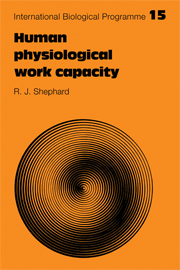Book contents
- Frontmatter
- Contents
- Foreword
- Preface
- 1 Introduction
- 2 Sampling and population studies
- 3 Methods for the measurement of physical fitness, working capacity and activity patterns
- 4 Climate, season and local geography
- 5 Socio-economic status and working capacity
- 6 Working capacity and constitution
- 7 The physical working capacity of the athlete
- 8 The growth of working capacity
- 9 Age and working capacity
- 10 Epilogue
- IBP Human Adaptability section publications
- References
- Index
9 - Age and working capacity
Published online by Cambridge University Press: 20 May 2010
- Frontmatter
- Contents
- Foreword
- Preface
- 1 Introduction
- 2 Sampling and population studies
- 3 Methods for the measurement of physical fitness, working capacity and activity patterns
- 4 Climate, season and local geography
- 5 Socio-economic status and working capacity
- 6 Working capacity and constitution
- 7 The physical working capacity of the athlete
- 8 The growth of working capacity
- 9 Age and working capacity
- 10 Epilogue
- IBP Human Adaptability section publications
- References
- Index
Summary
This chapter will examine the normal ageing of working capacity, and will consider what changes are induced by sustained athletic participation and by maintenance of a primitive life-style.
Normal ageing in more-developed countries
The normal ageing of working capacity has been the subject of several reviews (P. O. Åstrand, 1973; Roskamm, 1973; Shephard, 1973b). In the context of the IBP human adaptability project, it is sufficient to discuss the technical considerations of sample definition and measurement techniques, together with the usual course of changes in maximum oxygen intake, body fat, muscle strength, and vital capacity.
Technical considerations
In western society, such minor ailments as varicose veins or a ‘touch’ of bronchitis are considered almost a normal accompaniment of old age. Up to 50% of a 65-year-old population may have some diagnosable medical condition, and it becomes a difficult decision which individuals to exclude from the sample, particularly as many of the ailments in question can modify working capacity. For many purposes, it may be appropriate to include within the group all individuals who are sufficiently healthy to continue with their normal daily work.
Partly because of medical rejections and partly because caution increases with age, the proportion of a population volunteering for testing is progressively attenuated in the older age groups. We have observed this phenomenon equally when drawing a random sample of white subjects in Saskatoon (Bailey et al., 1974a) and when testing the whole Eskimo community of Igloolik (Shephard, 1974c).
Information
- Type
- Chapter
- Information
- Human Physiological Work Capacity , pp. 233 - 252Publisher: Cambridge University PressPrint publication year: 1978
